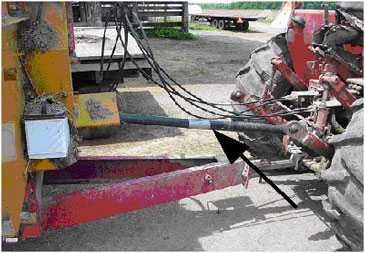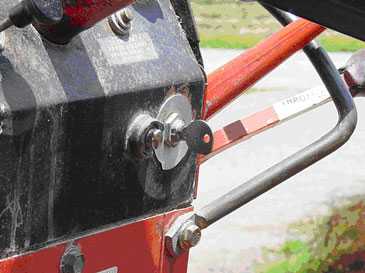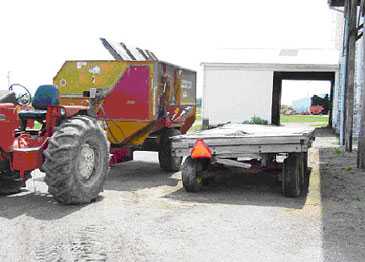Youth Farm Worker Dies After Falling Into Operating Feed Grinder/Mixer - Ohio
NIOSH In-house FACE Report 2002-10
November 20, 2003
Summary
On August 15, 2002, a 14-year-old male farm worker (the victim) died after falling into an operating cattle feed grinder/mixer. The victim was using a handheld hay hook to drop hay bales into the operating grinder from the top of a stack of hay bales. He apparently lost his footing, slipped, and fell into the grinder. Approximately 20 minutes later, a coworker entered the area and noticed that the grinder was running unattended. He then called out to the victim and received no response. After looking into the mixing/grinding area of the machine he realized that the victim had fallen into the operating grinder and immediately stopped the machine. Emergency Medical Service (EMS) was summoned via 911 and responded within minutes. The coroner pronounced the victim dead on site.
NIOSH investigators concluded that, to help prevent similar occurrences, employers should
- ensure that machinery such as top-loading feed grinders are positioned away from upper level work areas where employees could slip and fall into or onto it, and that the machinery is not operating during manual loading
- ensure that any keys which are required to operate equipment (tractor/power take off) are kept under the supervision and control of workers permitted to operate such machinery
- ensure compliance with child labor laws which restrict the type of work which youth less than 16 years of age are allowed to perform in agricultural settings
- ensure that constant supervision is provided when youth are present in a potentially hazardous working environment
- consider the use of a conveyor or other mechanical–type apparatus to elevate the feed (hay, corn silage, and alfalfa pellets) up to the loading point of the feed grinder
- develop, implement, and enforce a comprehensive safety program for all employees that includes, but is not limited to, training in hazard identification, avoidance, and abatement
Additionally,
- employers and equipment manufacturers should consider placing a warning sign or label on restricted agricultural equipment that indicates it is not to be operated by workers less than 16 years of age.
Introduction
On August 15, 2002, a 14-year-old male farm worker (the victim) died after falling into an operating cattle feed grinder/mixer (feed grinder) from above. On August 16, 2002, the U.S. Department of Labor, Wage and Hour Division, notified the National Institute for Occupational Safety and Health (NIOSH), Division of Safety Research (DSR), of the incident. An investigation was initiated by the Chief of the NIOSH Trauma Investigations Section (TIS) on September 17, 2002, with the Federal Wage and Hour investigator via telephone. On September 19 and 20, 2002, the NIOSH TIS Chief met with representatives of the County Sheriff’s Department as well as the Compliance Officer and Assistant Area Director from the U.S. Department of Labor, Occupational Safety and Health Administration (OSHA). The respective investigative case files and findings were reviewed. Photographs of the incident scene taken by these agencies, the coroner’s report, and EMS report were also reviewed. A telephone interview was conducted with the employer involved in the incident on September 23, 2002. On May 9, 2003, a site visit was conducted.
The employer involved in this incident was a co-owned dairy farm that had been in business for over 50 years and operated five farms at various locations at the time of the incident. The employer had 8 employees (including two youth workers – the victim and a 17- year-old male worker) that performed work supporting 126 dairy cows at the time of the incident.
The victim was a part-time summer employee and had been working for the employer for approximately 4 months prior to the incident. The victim worked an average of about 30 hours per week, with work shifts starting typically at 8:00 a.m. The victim’s summer term of employment was to be completed on August 17, 2002. The victim had been formally trained and possessed a certificate of training from 4H, through the Cooperative Extension Service, a service of the Ohio State University, for tractor operation. The employers had retained a copy of this certificate for their records. The certificate identified prohibited occupations in agriculture for children below the age of 16 including “operating or assisting to operate (including starting, stopping, adjusting, feeding, or any other activity involving physical contact associated with the operation) any of the following machines...feed grinder.”
The employer’s safety policies were un-written, however, in addition to the Extension Service training that the youth completed, all new employees were reportedly given hands-on and on-the-job training on how to perform various farm-related duties. Typical duties for the youth employees included feeding and tending the dairy cows, cleanup, operating tractors, and other farm labor duties as assigned.
This was the employer’s first workplace fatality.
Back to Top
Investigation
The feed grinder/mixer (feed grinder) involved in this incident was approximately 5 years old and had been purchased from the manufacturer new. The portable feed grinder was hitched to and powered by the power take-off (PTO) of a tractor (Photo 1). The tractor was operated by key, which was left in the ignition (Photo 2). The feed grinder was used on this dairy farm to mix, grind, and blend various feeds, including alfalfa pellets, corn silage, and hay to be fed to the dairy cattle.
 |
|
Photo 1. Depicts the power-take-off shaft engaging
the feed mixer-grinder from the rear of the tractor. |
 |
|
Photo 2. Depicts the key left in the ignition of the farm tractor that powers the feed mixer-grinder.
|
The victim had assisted the co-owner and co-workers with the feed grinding operation on previous occasions. According to a co-worker, the victim had been seen on top of the hay stack in the past, and had been told not to stand on top of the hay bales to directly load hay into the feed grinder. Normal procedures were to drop the hay bales from the hay stack down onto a hay wagon. The hay wagon had a working surface approximately 36 inches above ground level (Photo 3) that was positioned near the feed grinder. After the hay bales were dropped down to the hay wagon, employees would get on the hay wagon, hook the bales with a hand-hook, and throw the bales up into the feed grinder. (Note: The loading area of the feed grinder was approximately 7 feet in height, so the workers, while standing on the hay wagon, needed to throw the hay bales approximately 4 feet up and into the feed grinder. The hay bales measured approximately 36"x 18 ½” x 18 ½”, and according to the employer, weigh about 70 pounds when dry). Employees on the farm were reportedly prohibited from performing this operation alone. The victim was permitted only to assist the co-owner or another worker in performing the operation, and only as assigned.
 |
|
Photo 3. This photograph depicts the hay wagon that is used in the process of loading the feed grinder-mixer. Note: the hay wagon is normally positioned on the other side of the machine for loading purposes.
|
Earlier in the morning of the incident, the victim had reportedly gone to the co-owner asking for job duties. The co-owner stated that he did not have any at the time, and he directed the victim to go to the other co-owner for direction. The owners of the farm both stated that neither of them had assigned grinder loading duties to the victim on the day of the incident. Feeding of the cattle was not scheduled to occur until later in the day. Apparently the victim had not met with the other co-owner, but rather had decided to climb the hay stack and load the operating feed grinder from above. The hay stack was noted to be stacked nine bales high, making the working surface approximately 13 feet above the lower ground level. The victim’s work position was estimated at approximately 6 feet above the point(s) of operation* of the machine. During the process of loading the hay bales into the feed grinder, the victim apparently slipped down into the feed grinder auger area (Photo 4) and was killed instantly.
 |
|
Photo 4. This photo illustrates the auger portion of the feed mixer-grinder. Note the razor-blades mounted on the auger to facilitate cutting/grinding.
|
A co-worker had reported that at approximately 8:45 a.m. he had seen the victim in the area of the tractor and feed grinder and noted that the victim was on top of the hay stack. The coworker was in the process of driving a tractor down the road, away from the farm at the time. When the coworker returned at approximately 9:05 a.m., he attempted to locate the victim. The coworker noticed that the tractor and feed grinder were still operating, and the hay hook that the victim was apparently using was now lying on the ground on the side of the machine. The coworker stated that he looked into the feed grinder and observed the motionless victim. The coworker reportedly immediately shut off the machine and sought help. EMS was called and responded within minutes. On arrival EMS realized that the victim was deceased. The coroner was summoned and pronounced the victim dead at the site.
*According to the Occupational Safety and Health Administration (OSHA), the point of operation on a machine is “the area on a machine where work is actually being performed upon the material being processed”.
Back to Top
Cause of Death
The cause of death listed on the coroner’s report was multiple traumatic injuries.
Recommendations and Discussion
Recommendation #1: Employers should ensure that machinery such as top-loading feed grinders are positioned away from upper level work areas where employees could slip and fall into or onto it, and that the machinery is not operating during manual loading.1
Discussion: Machinery such as top-loading feed grinders and other dangerous equipment should be positioned away from upper levels where employees could slip and fall into or onto it. The operator’s manual for the grinder in this incident includes such guidance: “do not operate mixer if any person is positioned near or over the top of box.”
The manufacturer’s operator’s manual states “do not hand load materials while unit is running.” The co-owner stated that the normal procedure for this operation was to throw the bales of hay down onto a hay wagon with a working surface level approximately 36 inches from the ground and then get on the hay wagon, hook the bales with a hand-hook, and throw the bales up into the operating grinder.
Recommendation #2: Employers should ensure that any keys that are required to operate equipment (tractor/power take off) are kept under the supervision and control of workers permitted to operate such machinery.
Discussion: The victim involved in this incident had access to the keys (they were left in the ignition) used to operate the tractor dedicated to the feed grinder/mixer. The possession of the keys in turn provided him direct access to the machinery (feed mixer/grinder) attached to the tractor’s PTO. Employers should consider means of maintaining control of keys only by experienced, trained, and/or authorized workers, so that other workers would be unable to operate prohibited and/or dangerous machinery.
Recommendation #3: Employers should ensure compliance with child labor laws which restrict the type of work youth less than 16 years of age are allowed to perform in agricultural settings.2-5
Discussion: The Fair Labor Standards Act (FLSA), enacted in 1938, includes child labor provisions that prohibit the employment of youths in jobs and under conditions detrimental to their health or well-being. Unless a specific exemption applies, 14 is the minimum age for employment in agricultural activities that are not deemed hazardous by the Secretary of Labor. Among the jobs considered hazardous and prohibited for employees under 16 years of age are: operating or assisting to operate (including starting, stopping, adjusting, feeding, or any other activity involving physical contact associated with the operation ) a variety of farm machinery, including feed grinders. Employers should take steps to ensure that youth are not performing inappropriate work tasks.
The training certificate held by the victim identified prohibited occupations in agriculture for children below the age of 16.
Recommendation #4: Employers should ensure that constant supervision is provided when youth are present in a potentially hazardous working environment. 3
Discussion: The youth victim involved in this incident had gone to one co-owner to find work assignments. There were no assignments to be given at the time, and the youth was told to go to the second co-owner for work assignments. Without talking to the second co-owner, the youth apparently proceeded to the feed grinder and began loading it from above. The youth was unsupervised on the farm at the time of the incident. When youths are present in the work environment, constant supervision may be necessary to completely ensure their health and safety.
Recommendation #5: Employers should consider the use of a conveyor or other mechanical –type apparatus to elevate the feed (hay, corn silage, and alfalfa pellets) up to the loading point of the feed grinder.
Discussion: A conveyor, hay chute, or other mechanical equipment (such as a loader with fork attachment) could be used to facilitate the loading of the grinder, and would prevent exposure of employees to potential lifting injuries in addition to the likelihood of the employees being positioned above the grinder. In this case, the victim apparently was loading the grinder by the easiest means available to him at the time, dropping the hay bales in the grinder from above.
Recommendation #6: Employers should develop, implement, and enforce a comprehensive safety program for all employees that includes, but is not limited to, training in hazard identification, avoidance, and abatement. 2,3
Discussion: Employers should develop, implement, and enforce a comprehensive safety program. This program should include safe work procedures for all tasks performed by workers and specifically outline and identify the hazardous occupations in agriculture that youth less than 16 years of age should not perform. Workers should be trained in these safe work procedures, and the training should be documented. The safety program should also contain training in hazard awareness, identification and control, and the conduct of routine/daily inspections.
Training in recognizing and avoiding hazards should be given to all workers (including the employers), and older workers need to be trained on what youth can and cannot do so they can correct unsafe behavior and not assign youth inappropriate work. This is especially important on farms in view of the size and power of the machines used.
Youth may lack the judgment necessary to protect their own safety and health. In this incident, the 14-year-old victim may not have been aware or fully capable of understanding the safety risks associated with working above the operating feed grinder or the possibility of slipping into the mixer. Employers should make frequent assessments to determine if their young workers are competent in the recognition of hazards and safe work practices. Additional training should be conducted and be specific to the tasks being performed.
Additionally,
Employers and equipment manufacturers should consider placing a warning sign or label on restricted agricultural equipment that indicates it is not to be operated by workers less than 16 years of age. 2,4,5
Discussion: Employers and manufacturers should consider placing warning signs, markings (legible painted signs), or labels on equipment that indicate that workers less than 16 should not operate or work with the equipment. These warnings should be affixed in a conspicuous place on those machines that youths under the age of 16 are not allowed to operate and note this restriction in the operator’s manual. Employers and equipment manufacturers can obtain assistance in identifying machines that are not to be used by workers less than 16 years of age by calling their local DOL Wage and Hour Division office. Information on agricultural machines that youth less than 16 should not operate are available in department of labor publications and the internet at: http://www.dol.gov/whd/regs/compliance/whdfs40.pdf. (Link updated 1/12/2010)
Back to Top
References
- Manufacturer’s Operator’s Manual. 1997.
- DOL [1990]. Child labor requirements in agricultural occupations under the Fair Labor Standards Act. Washington D.C.: U.S. Department of Labor, Employment Standards Administration, Wage and Hour Division WH 1295.
- NIOSH [2003]. NIOSH Alert: Preventing Deaths, Injuries, and Illnesses of Young Workers. Cincinnati, OH: U.S. Department of Health and Human Services, Public Health Service, Centers for Disease Control and Prevention, National Institute for Occupational Safety and Health, DHHS, (NIOSH) Publication No. 2003-128.
- DOL (U.S. Department of Labor) [2002]. Prohibited occupations for agricultural employees. [www.dol.gov/elaws/esa/flsa/docs/hazag.asp]. Accessed November, 2003.
- DOL (U.S. Department of Labor) [2003]. Fact Sheet 40: Federal child labor laws in farm jobs. [http://www.dol.gov/whd/regs/compliance/whdfs40.pdf]. Accessed November, 2003. (Link updated 1/12/2010)
Investigator Information
This incident was investigated by Robert E. Koedam M.S., Chief, Trauma Investigations Section, Surveillance and Field Investigations Branch, Division of Safety Research, NIOSH.
In-house Reports
- Page last reviewed: November 18, 2015
- Page last updated: October 15, 2014
- Content source:
- National Institute for Occupational Safety and Health Division of Safety Research


 ShareCompartir
ShareCompartir